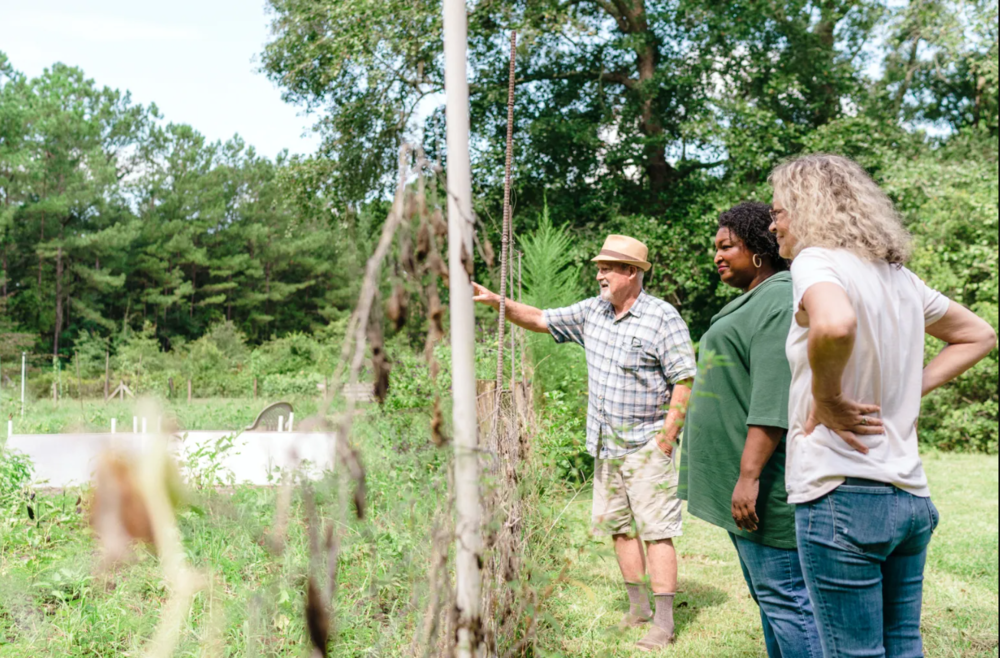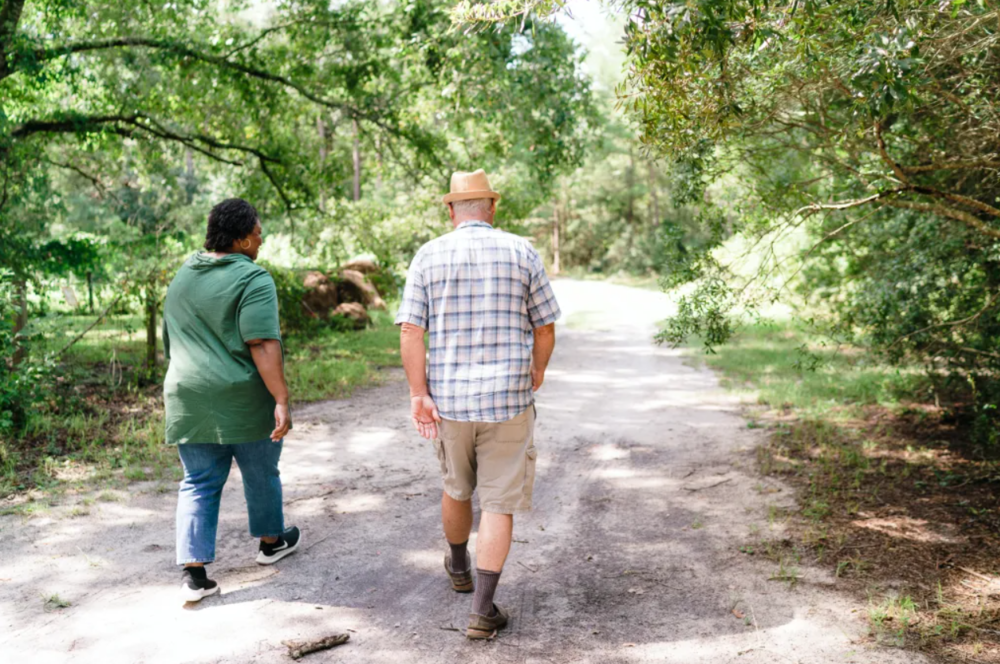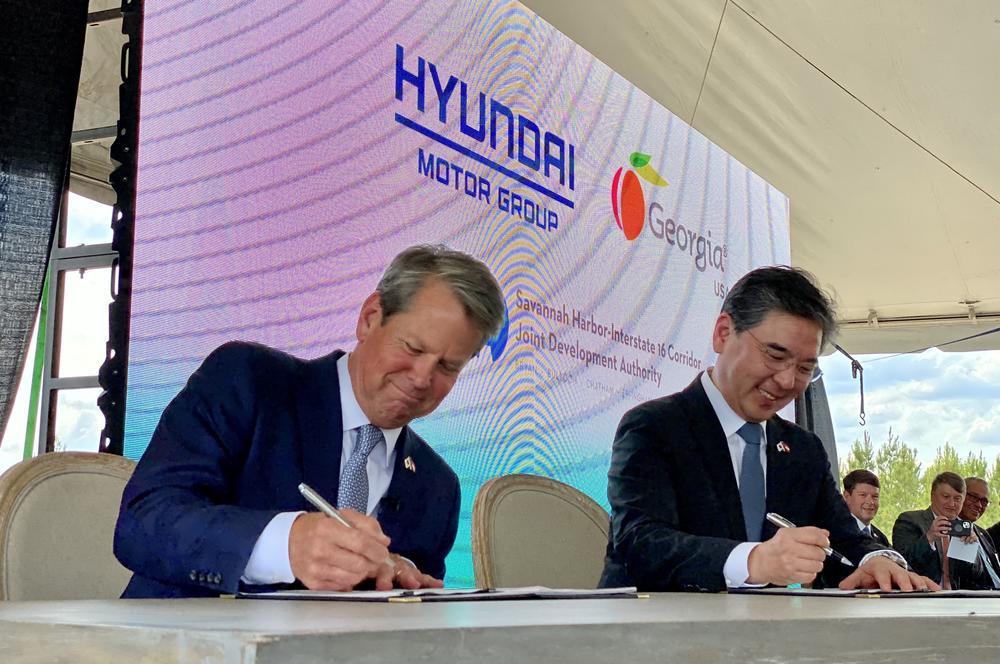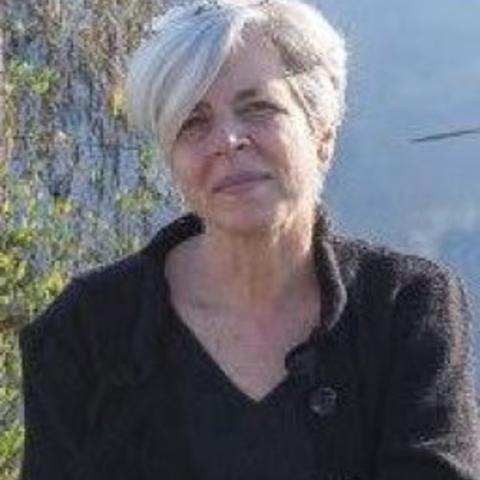
Section Branding
Header Content
Abrams’ environmental focus: resilience, green jobs, lower energy costs
Primary Content

Mary Landers, The Current
In the middle of a campaign swing through Coastal Georgia, Democratic candidate for governor Stacey Abrams stopped Saturday at Green Bridge Farm in fast-growing Effingham County. There, founder Michael Maddox showed off the vegetable gardens that help feed the 10 families that live in the 25-acre “agrihood,” where small houses and wooded lots are the norm.
Maddox’s blueberry crop failed in each of the last two years after producing berries for two decades. “I lost my entire blueberry crop to a late freeze,” he said, blaming the unpredictability on climate change.

Abrams is worried about climate change, too, especially along the Georgia coast and in South Georgia where small farmers like Maddox struggle with a less stable climate and all the residents face growing threats from hurricanes and rising sea levels. Her concerns are part of an seven-page environmental protection and resilience plan Abrams unveiled in an interview with The Current.
The Democratic leader says she would support three concrete goals if elected governor this fall: better resilience in the face of climate change; the creation of at least 25,000 green energy jobs over the next four years; and reduced energy costs for Georgians.
“To ensure Georgia’s communities continue to thrive, for now and for years to come, we must better protect our abundant natural resources, reduce greenhouse gas emissions and decarbonize, and leverage the economic benefits of advanced energy to secure a more resilient future,” the six-page policy paper states.
In a tight race with Gov. Brian Kemp, where Abrams and the incumbent have tussled over economic and legislative priorities, the one-time state legislator is hoping that her environment plan distinguishes her among likely Georgia voters.
Earlier this month Kemp touted Georgia’s designation as third-best in the country for environmental sustainability by Site Selection magazine, Atlanta CEO reported. Kemp credited that status with helping to attract electric vehicle manufacturers including Rivian and Hyundai Motor Group. While he frequently boasts thousands of jobs created in Georgia by the electric vehicle industry, Kemp’s campaign site has no position paper on the environment.

Abrams’ engagement with environmental issues goes back to her undergraduate years at Spelman College in the mid-1990s. She interned for two summers with the Environmental Protection Agency and wrote her thesis about the so-called cancer alley in Louisiana, an area with a heavy concentration of petrochemical plants.
“I’m the only candidate who not only has a plan, but has the experience to execute that plan. I didn’t discover the environment, it has been a part of who I am,” she said during 30-minute interview on Sunday at the 520 Tavern in Savannah.
At the Georgia House of Representative where Abrams served as Minority Leader from 2011-2017, she burnished her green bona fides by working across the aisle with unlikely political allies to protect the state’s waterways.
“Probably the most interesting one was working with the Georgia Tea Party to block the stream buffer erosion bill that the Chamber (of Commerce) tried to pass for several years,” Abrams said. “And we were able to block that bill by combining Democrats and members of the Tea Party because it was bad for the environment and bad for property taxes.”
In 2019 she founded the nonprofit Southern Economic Advancement Project, which has focused on environmental justice as a main issue, publishing several reports about climate change and building resilience in the face of it.
The bipartisan, nonprofit Georgia Conservation Voters endorsed Abrams before she published her environmental platform due to her responses to the nonprofit’s questionnaire. There, Abrams emphasized the importance of building the workforce of the future, with a focus on green job training and growth. That philosophy resonates with Executive Director Brionte McCorkle.
“The common refrain that Georgia is the number one state to do business is really under threat here if they don’t get it together with climate change and sustainability,” McCorkle said. “So I think that having a governor who gets the importance of making sure that Georgia is positioned to do well as we transition to a more sustainable future powered by renewable, clean energy is really important.”
Integral to the creation of the plan was Allison Bridges, a researcher and lecturer at the Columbia University Climate School and at Emory University specializing in environmental policy and planning, urban sustainability, and climate resiliency. Individuals from leading Georgia environmental groups including Sierra Club, 100 Miles, Georgia Conservation Voters, and the U.S. Green Building Code contributed to the plan in their individual capacities.
In unveiling her environmental priorities, Abrams gave detailed answers about the problems she believes are facing Georgia. She presented a mix of methods to pay for the solutions, including tapping into federal funds and establishing a Green Development Bank, a quasi-governmental lending institution other states have established to fight climate change.
Voters won’t find a mention of the North Atlantic right whale or loggerhead sea turtles in Abrams’ plan. Instead, it’s focused on struggling Georgians and connecting climate threats to their lives.
Better resilience
Georgia’s 11 million residents are vulnerable to both hurricanes from the Atlantic coast and “back-door” storms from the Gulf of Mexico. Climate change makes those hurricanes intensify more quickly, and produce more rain. Combined with sea level rise, hurricanes are also producing higher storm surges, while flooding from ordinary storms is also more common.
In the event of such catastrophic weather events, Abrams wants the state to take a larger role in establishing and running emergency shelters as well as providing transportation to evacuate to those shelters. These functions are now filled by local governments and nonprofits and backfilled by federal agencies like the Federal Emergency Management Agency and the Georgia Emergency Management Agency.
Abrams’ plan calls for more state-sponsored shelters to handle what she believes are the growing numbers of communities affected by adverse weather. She didn’t give details on how the state would fund these shelters.
“Georgia is going to face some more and more real-life effects from climate action,” Abrams said. ”We are seeing extreme weather events taking their toll over and over again.”
“So it’s making sure that we’ve got state-sponsored shelters, as well as those Red Cross shelters, because those shelters fill up quickly. And those shelters are entirely dependent on resources that come in at first through donations,” Abrams said. “Yes, they will get FEMA dollars and GEMA dollars. But we know sometimes that money takes a while to get there. And they are often overwhelmed and under-resourced.
“If we know there’s a storm coming, because they’re going to be coming, we should be anticipating what that looks like. And making sure that we’ve got an adequate number of shelters, but also the transportation to move people.”
Her priority comes from personal experience. In Mississippi, when Hurricane Katrina hit, her parents’ church became the local shelter before the Red Cross got there, she said.
Abrams also said she wants the government to work with residents to ensure resilience in housing and infrastructure, especially for people living in Coastal Georgia.
“If you are living in a coastal low lying area, it’s great to tell you you need to do something to prepare your home but it’s quite another to have the government work with you to actually if you need to do retrofitting, if you need to invest in maybe getting a setback, whatever those things need to be we need to start thinking now about what that means. Because if you’re in Glynn County, if you’re in Bryan County, if you’re in Chatham County, you can’t figure it out the day after the storm.”
Abrams says she’ll task GEMA with preparing a Coastal Resilience Plan and separate South Georgia Readiness Plan. She also plans to appoint a Chief Resilience Officer in the Office of the Governor to coordinate environmental policies across state agencies.
Energy jobs
Abrams believes Georgia can create between 25,000 and 40,000 “advanced energy” jobs in the next four years by taking advantage of funding in the Inflation Reduction Act. These jobs are in renewable energy fields including solar, wind and biomass.

Kemp has created energy-related jobs in the form of two electric vehicle manufacturers. Rivian Automotive is expected to build its 7,500-job, $5 billion electric vehicle plant east of Atlanta. Hyundai is investing $5.54 billion in opening an electric vehicle and battery manufacturing site in Bryan County.
Abrams, however, says she’s well placed to develop more green energy jobs by leveraging federal funds, and by launching what she calls a Georgia Green Development Bank.
Green Banks already exist in Connecticut, New York, Rhode Island, California, Hawaii, and Montgomery County, Maryland. In their first five years the earliest banks invested nearly $575 billion in clean energy projects. Though some are founded with public money, others have a mix of public and private capital and all offer loans, not grants.
Abrams says the Inflation Reduction Act includes money earmarked for states to start their own Green Banks.
“We can work with public and private providers to draw down federal dollars, but also invest in small businesses and in growing businesses to ensure that we’re creating those jobs,” Abrams said.
For the skilled workforce required for advanced energy jobs, Abrams wants to expand access to technical college by making it free for every student.
“We can get people into the pipeline so that when these dollars become available, we’ve got workers who can do that job,” she said.
Georgia is ranked seventh in terms of solar energy production, though most of that production is utility scale rather than rooftop, which generates local jobs. Georgia can do better, Abrams said, thanks to the hundreds of millions of dollars in federal funding for this sector that will become available under the bipartisan Infrastructure Investment and Jobs Act and Inflation Reduction Act just signed by the White House.
Another area ripe for job creation, according to Abrams, is electric vehicle charging stations.
“You’re gonna have to build them, you’re gonna have to maintain them, we’re going to have to do the planning for them,” she said. “And those are all jobs that will be permanent jobs in Georgia once they’re created.”
Reduced energy costs
A pocketbook issue for every Georgia, the cost of energy is the third pillar in Abrams’ plan.
“We have aging infrastructure that’s costing us more money, repairs cost more, because we’ve taken too long to get through them. And that means whether we’re looking at the production of energy or looking at water usage, there are many things we can do with infrastructure that can actually reduce costs, and improve access for our communities.”
She points to poorly insulated buildings as a significant cost factor for residents and local government, and promises to figure out tax incentives that make it cost-effective for both to retrofit and upgrade.
Abrams also points to a need for greater government help in solving structural problems among municipalities to upgrade septic and sewer systems.
“In Atlanta, it costs us almost $4 billion to retrofit our water sewer system,” Abrams said. “Valdosta has been asking for the same permission from the state and they’ve been denied year over year. They cannot get the ability to tax themselves to fix a water sewer system. As governor, I want to make certain that no matter where you are, we can help your local community respond.”
She also extended criticism to the state monopoly utility and the elected energy regulators on the Public Service Commission. The commission has failed consumers repeatedly, most recently by not forcing Georgia Power to adopt net metering, which pays for electricity fed to the grid by rooftop solar at the same rate as Georgia Power gets paid, she said.
“I want to make certain that we pass legislation that actually incentivizes better behavior,” she said. “Unfortunately, the PSC has been unwilling to think about the consumer side, I think, sufficiently, in terms of its job. We also need legislation at the state level that pushes harder to make net metering and reducing energy costs the state’s responsibility. It is insufficient for us to devolve that obligation to the PSC when the state legislature and the governor can take the lead. And I intend to do so as the next Governor of Georgia.
Abrams on 10 key coastal environmental issues:
Protecting Coastal and South Georgia: “When you look at the predictive models of climate action and climate change, those communities are going to be the most vulnerable. But we also know that’s where the port is. That’s where our military installations are. That’s where the bulk of our agricultural industry is. And so how we survive as a state is embedded in those communities.”
Electric vehicles: Georgia had a $5,000 state tax credit for EV buyers before the passage of the 2015 Transportation Act. Georgia House of Representatives Minority Leader at the time, Abrams fought unsuccessfully to keep the credit in place. “I would absolutely push to renew those tax credits,” she said.
Rooftop solar: Georgia has limited net metering, the system where utilities buy rooftop solar production at the same rate they sell it to consumers, making solar a better investment for homeowners. Georgia Power allows 5,000 customers to participate in a net metering pilot, which they declined to expand earlier this year. “Sadly, Georgia is behind in really understanding how we can make net metering effective across the board. That is going to be one of the first things I do. I want to make sure that we have an energy commission that is looking at and working with the PSC, but looking at it from the perspective of 'what can the state be doing to incentivize moving towards net metering?'"
Mining near the Okefenokee: Alabama-based Twin Pines Minerals plans to mine for titanium dioxide near the Okefenokee National Wildlife Refuge, a project that has met with opposition from environmentalists. “I need to do more research, but my superficial research tells me I oppose it. I think the Okefenokee is a singular feature in Georgia and the mining will not only disrupt the ecology, but the utility of it, to me, is questionable, given the other opportunities that we will forfeit if that mining occurs.”
Spaceport Camden: A Camden County plan to build a spaceport for the launch of up to 12 small rockets a year received approval from the Federal Aviation Administration but then local voters quashed the purchase of the spaceport land in a special referendum. The validity of that vote is now a question before the state Supreme Court. As a legislator, I supported the right for Camden to explore that spaceport; I voted for the legislation. It strikes me that the overall determination is that this is not going to move forward, that the community, given the option to participate and decide, has decided against it. And I believe in local control.”
Hurricane evacuation: Abrams wants the state to better support both hurricane shelters and transportation for hurricane evacuation, with a special emphasis on getting the most vulnerable to safety. “It’s making sure that we’ve got state sponsored shelters, as well as those Red Cross shelters, because those shelters fill up quickly. And those shelters are entirely dependent on resources that come in at first come in through donations. Yes, they will get FEMA dollars and GEMA dollars. But we know sometimes that money takes a while to get there.”
High-speed rail: There have been conversations about high speed rail from Savannah to Atlanta for years. In March, the Georgia Department of Transportation pledged $8 million to study the feasibility of the project. Abrams is a fan. “High Speed Rail means that you connect to opportunity, but you don’t have to get on the train if you don’t want to. And we also know that it provides access to transportation options that are often denied to low income and vulnerable communities. And so it solves both. It gets people off the roads, it increases the connectivity and creates new jobs.”
High cost of energy: Electricity and natural gas rates for consumers are regulated in large part by the elected five-member Georgia Public Service Commission. “We need voices that are consumer friendly voices on the PSC, but we also need legislation at the state level, that pushes harder to make net metering and reducing energy costs the state’s responsibility. It is insufficient for us to devolve that obligation to the PSC when the state legislature and the governor can take the lead. And I intend to do so as the next Governor of Georgia.”
Biomass: With more privately owned timber than any other state, Georgia counts biomass, including wood pellets, among its most abundant renewable resources. Environmental groups including the Dogwood Alliance and the Southern Alliance for Clean Energy, are skeptical about the benefits of burning wood for energy. Abrams says Georgia has to figure out how to do biomass right. “And because Georgia is one of the top producing timber states in the nation, because we have the detritus that’s leftover, it is worth thinking about how do we make biomass not only energy efficient, but cost effective and not toxic to the environment? Part of that means that you have to have a community that cares about it, it’s incentivized to think about it. I want Georgia to be on the forefront of that research. I want us to be the ones who figure out if biomass is both sustainable and environmentally friendly.”
Linking health and the environment: Abrams wants to expand Medicaid. She notes that Georgia has 23 Superfund sites, four of them in Glynn County. “But when it comes to environmental issues, we then have the ability to put doctors and nurses and health care professionals in spaces where they are most desperately needed to mitigate the harm of environmental inaction or worse, environmental harm that has been done through environmental racism, or environmental injustice.”
This story comes to GPB through a reporting partnership with The Current, providing in-depth journalism for Coastal Georgia.

